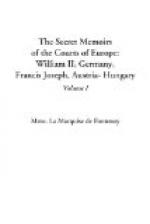The studio of the archduchess is situated on the second floor of her palace, in the Favoritenstrasse, and is a very lofty, long and narrow apartment, looking out on the street. It is particularly remarkable for its simplicity, presenting therein a powerful contrast to the magnificence of the two salons through which it is necessary to pass in order to reach it. The few stools, tabourets, armchairs and divans therein contained, are upholstered with soft-toned Oriental rugs, the walls are hidden by some sort of olive-colored velvety fabric, and the wall opposite the windows is divided in the middle by a species of gallery, the exquisite wood carvings of which were brought by the archduchess herself from Meran. The parqueted floors are partly concealed by the skins of tigers and polar bears, shot in the Arctic regions and in India by her brother, Dom Miguel, Duke of Braganza, the legitimist pretender to the throne of Portugal, while on easels, and suspended from the walls, are oil-color portraits by the archduchess of Baroness C. Kolmossy, to whom she is indebted for her knowledge of painting, of her husband, the late Archduke Charles-Louis, and of her sister-in-law, the lamented Empress Elizabeth, in riding habit and in ball-dress.
There is also a very pretty picture of a cat in the act of effecting its escape from the basket in which it had been confined, and a wonderful crayon sketch of Maria-Theresa’s stepson, Archduke Francis-Ferdinand, the heir to the Austro-Hungarian throne. The colossal fire-place niched in one of the corners of the studio, is surmounted, not by a mirror, but by a panel of well-nigh priceless Oriental embroidery, the brilliant colors of which have been softened and rendered harmonious and mellow by age.
The doors are draped by portieres of Flemish tapestry, and shielded by Mucharabieh screens of curiously-carved wood from Cairo. Preserved from dust and damage beneath plate-glass are some unique pieces of antique Venetian point lace, presented by another brother-in-law, Don Alfonso of Spain, the younger brother of the Pretender Don Carlos, while on a huge square writing-table, the equipments of which are of Oriental gold filigree-work, richly jewelled, are usually found letters either to or from the favorite brother-in-law of the archduchess, Duke Charles-Theodore of Bavaria, the celebrated oculist, who during the course of his practice has performed more than three thousand successful operations for cataract without accepting a single penny-piece by way of remuneration.
True, the patients of this royal physician are nearly all of them poor people, and it is for their benefit that he has converted one of his castles into an ophthalmic hospital, and another palace into a species of convalescent home and resort, where poor gentlefolk and government servants with inadequate means can spend a couple of weeks in the country free of all cost.
It is difficult to refrain from a deep degree of sympathy for this so brilliant and accomplished Archduchess Maria-Theresa, whose character is best illustrated by the fact that she is literally worshipped by her grown-up step-children. The sudden death of her husband was not only a cruel bereavement, but was also the destruction of great and much-cherished ambitions.




